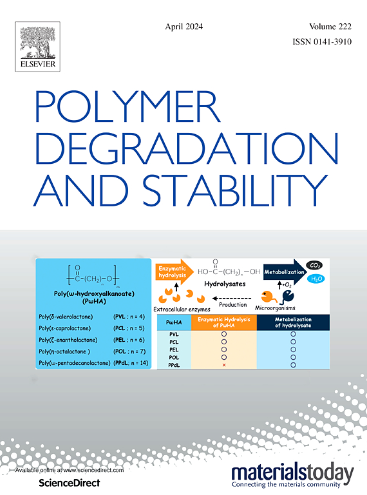氮掺杂碳量子点/木质素磺酸钠协同增强聚对苯二甲酸乙二醇酯(PET)薄膜阻燃性能的研究
IF 7.4
2区 化学
Q1 POLYMER SCIENCE
引用次数: 0
摘要
聚对苯二甲酸乙二醇酯(PET)织物因其优异的机械强度、高弹性、抗皱性和耐磨性被广泛应用于我们的生活中,但其易燃性造成了火灾事件的风险,因此对PET进行阻燃处理是必要的。碳量子点和木质素磺酸钠共同作用的阻燃剂可以很好地克服目前阻燃剂添加量大、环境危害大、热稳定性差的缺点。本文以四氮唑(Tet)和甘油(Gly)为原料,采用一步热溶剂法制备了n掺杂CQDs/木质素磺酸钠/PET复合薄膜(NCQDs/Sodi@PET薄膜),并以木质素磺酸钠作为分散剂接枝到PET薄膜表面。阻燃试验表明,NCQDs/Sodi@PET的UL-94等级为V-0, LOI值为30%,残碳率从10.6%提高到18.2%,峰值放热率从1 667 kW/m2降低到373 kW/m2,燃烧生长指数(FGI)降低了56%,燃烧性能指数(FPI)提高了160%。本工作为制备具有优异阻燃性能和热稳定性的阻燃PET织物提供了一种新方法,实验结果表明,n掺杂碳量子点对聚合物气相燃烧的影响是有效的。本文章由计算机程序翻译,如有差异,请以英文原文为准。
Study of nitrogen-doped carbon quantum dots/sodium lignosulfonate synergistic enhancement of flame retardant properties of polyethylene terephthalate (PET) films
Polyethylene terephthalate (PET) fabrics are widely used in our lives due to their excellent mechanical strength, high elasticity, wrinkle resistance and abrasion resistance, but their flammability creates a risk of fire events, so flame retardant treatments for PET are necessary. Flame retardants with carbon quantum dots and sodium lignosulfonate acting together can well overcome the shortcomings of the current flame retardants with large additions, environmental hazards and poor thermal stability. In this paper, N-doped CQDs/sodium lignosulfonate/PET composite film (N![]() CQDs/Sodi@PET films) was prepared by a one-step hot solvent method using tetrazolium (Tet) and glycerol (Gly) as raw materials and grafted onto the surface of PET films using sodium lignosulfonate as a dispersant. Flame retardancy tests showed that N
CQDs/Sodi@PET films) was prepared by a one-step hot solvent method using tetrazolium (Tet) and glycerol (Gly) as raw materials and grafted onto the surface of PET films using sodium lignosulfonate as a dispersant. Flame retardancy tests showed that N![]() CQDs/Sodi@PET had a UL-94 rating of V-0 and an LOI value of 30 %, the residual carbon rate was increased from 10.6 % to 18.2 %, the peak heat release rate was reduced from 1 667 kW/m2 to 373 kW/m2, and the fire-growth index (FGI) was reduced by 56 % and the fire performance index (FPI) was improved by 160 %. This work provides a new method for the preparation of flame retardancy PET fabrics with excellent flame retardancy and thermal stability properties, and the experimental results show that the effect of N-doped carbon quantum dots on the gas phase of polymer combustion is effective.
CQDs/Sodi@PET had a UL-94 rating of V-0 and an LOI value of 30 %, the residual carbon rate was increased from 10.6 % to 18.2 %, the peak heat release rate was reduced from 1 667 kW/m2 to 373 kW/m2, and the fire-growth index (FGI) was reduced by 56 % and the fire performance index (FPI) was improved by 160 %. This work provides a new method for the preparation of flame retardancy PET fabrics with excellent flame retardancy and thermal stability properties, and the experimental results show that the effect of N-doped carbon quantum dots on the gas phase of polymer combustion is effective.
求助全文
通过发布文献求助,成功后即可免费获取论文全文。
去求助
来源期刊

Polymer Degradation and Stability
化学-高分子科学
CiteScore
10.10
自引率
10.20%
发文量
325
审稿时长
23 days
期刊介绍:
Polymer Degradation and Stability deals with the degradation reactions and their control which are a major preoccupation of practitioners of the many and diverse aspects of modern polymer technology.
Deteriorative reactions occur during processing, when polymers are subjected to heat, oxygen and mechanical stress, and during the useful life of the materials when oxygen and sunlight are the most important degradative agencies. In more specialised applications, degradation may be induced by high energy radiation, ozone, atmospheric pollutants, mechanical stress, biological action, hydrolysis and many other influences. The mechanisms of these reactions and stabilisation processes must be understood if the technology and application of polymers are to continue to advance. The reporting of investigations of this kind is therefore a major function of this journal.
However there are also new developments in polymer technology in which degradation processes find positive applications. For example, photodegradable plastics are now available, the recycling of polymeric products will become increasingly important, degradation and combustion studies are involved in the definition of the fire hazards which are associated with polymeric materials and the microelectronics industry is vitally dependent upon polymer degradation in the manufacture of its circuitry. Polymer properties may also be improved by processes like curing and grafting, the chemistry of which can be closely related to that which causes physical deterioration in other circumstances.
 求助内容:
求助内容: 应助结果提醒方式:
应助结果提醒方式:


